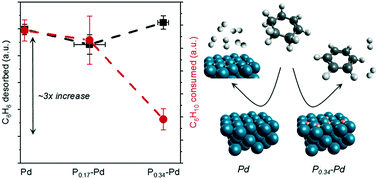Effects of phosphorus addition on selectivity and stability of Pd model catalysts during cyclohexene dehydrogenation†
Abstract
Transition metal phosphides are more selective for hydrocarbon dehydrogenation than the corresponding unmodified transition metals, however there are few detailed experiments probing thermodynamics and kinetics of adsorption and reactions of hydrocarbons on these surfaces. Here, we use a combination of temperature programmed reaction (TPR) and reactive molecular beam scattering (RMBS) of cyclohexene (C6H10) and benzene (C6H6) and temperature programmed desorption of CO and H2 to examine how the addition of P-atoms alters the catalytic properties of Pd(111) for non-oxidative dehydrogenation of C6H10 to C6H6. Quantitative analyses of TPR results demonstrate that a phosphorus modified Pd(111) surface (P0.34–Pd) dehydrogenates C6H10 to C6H6 with a selectivity approaching 100%, which is ∼3-fold greater than that of the unmodified Pd(111) surface (∼30%). These differences in selectivity correlate with a significantly reduced desorption energy for small molecules (e.g., CO, C6H6, C6H10, H2) on P0.34–Pd in comparison to Pd(111). Together these comparisons suggest that adsorbates exchange less charge with P0.34–Pd than with Pd(111), which agrees with prior computational predictions. Diminished electron exchange between Pd atoms and bound reactive intermediates leads also to greater near steady-state selectivities for dehydrogenation of C6H10 to C6H6, decreased rates of C–C bond rupture, and increased catalyst stability. Apparent activation energies for dehydrogenation of C6H10 are lower for Pd (−13 kJ mol−1) than P0.34–Pd (−7 kJ mol−1), while those for C6H6 decomposition seem to differ more significantly (∼90 kJ mol−1 on Pd; immeasurable rates and barrier for P0.34–Pd) as shown by the RMBS of C6H10 and C6H6 respectively. As a consequence, P also increases apparent barriers for catalyst deactivation observed during RMBS of C6H10 (1 kJ mol−1 on Pd to 38 kJ mol−1 on P0.25–Pd) due to the decreased tendency to decompose C6H6 to more hydrogen-deficient forms of carbon. These results demonstrate that the presence of P-atoms on and within the near surface region of Pd significantly impacts the energetics of C–H and C–C bond rupture pathways in ways that lead to greater selectivities and stabilities for hydrocarbon dehydrogenation reactions.

- This article is part of the themed collection: 2020 Catalysis Science & Technology Hot Articles


 Please wait while we load your content...
Please wait while we load your content...